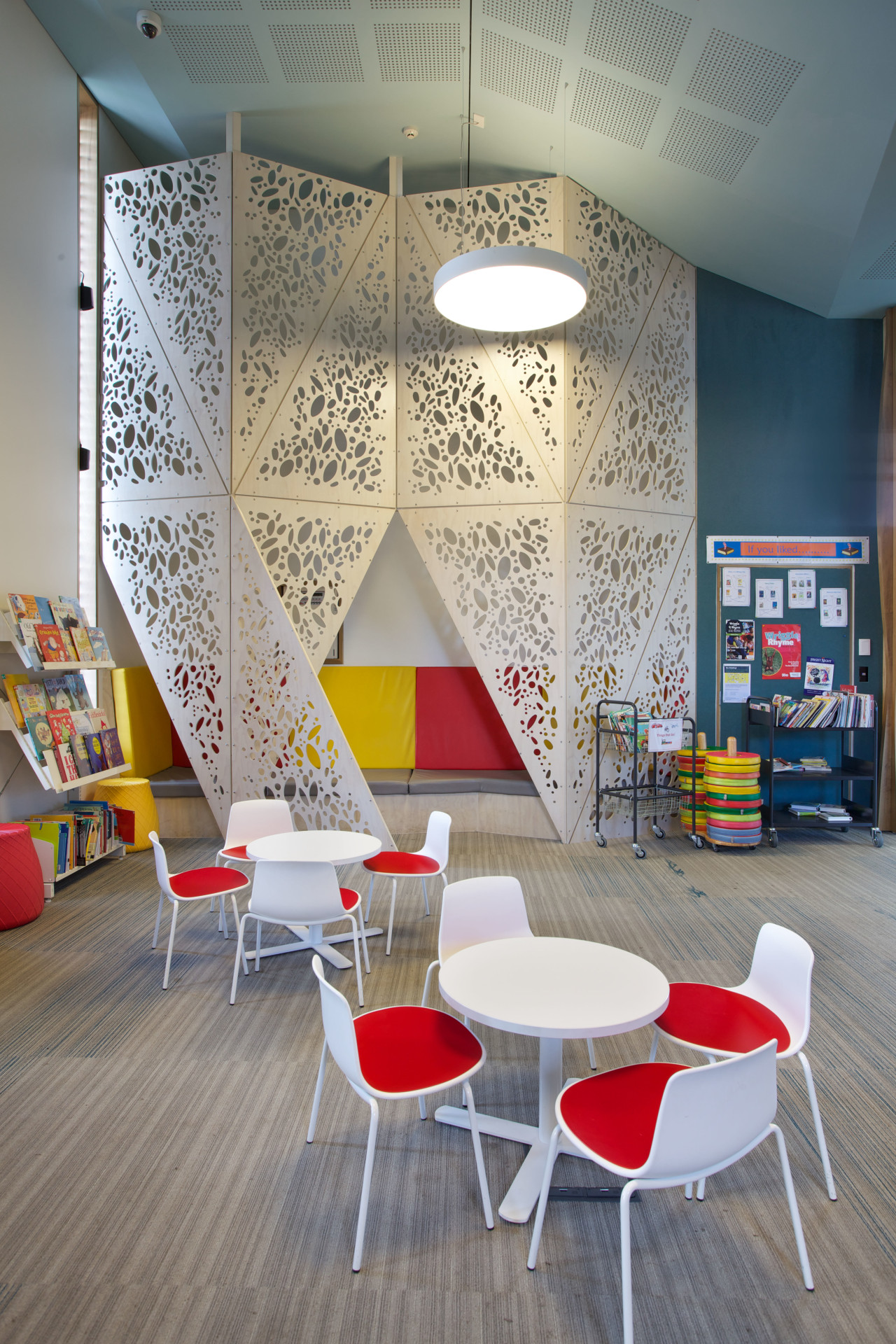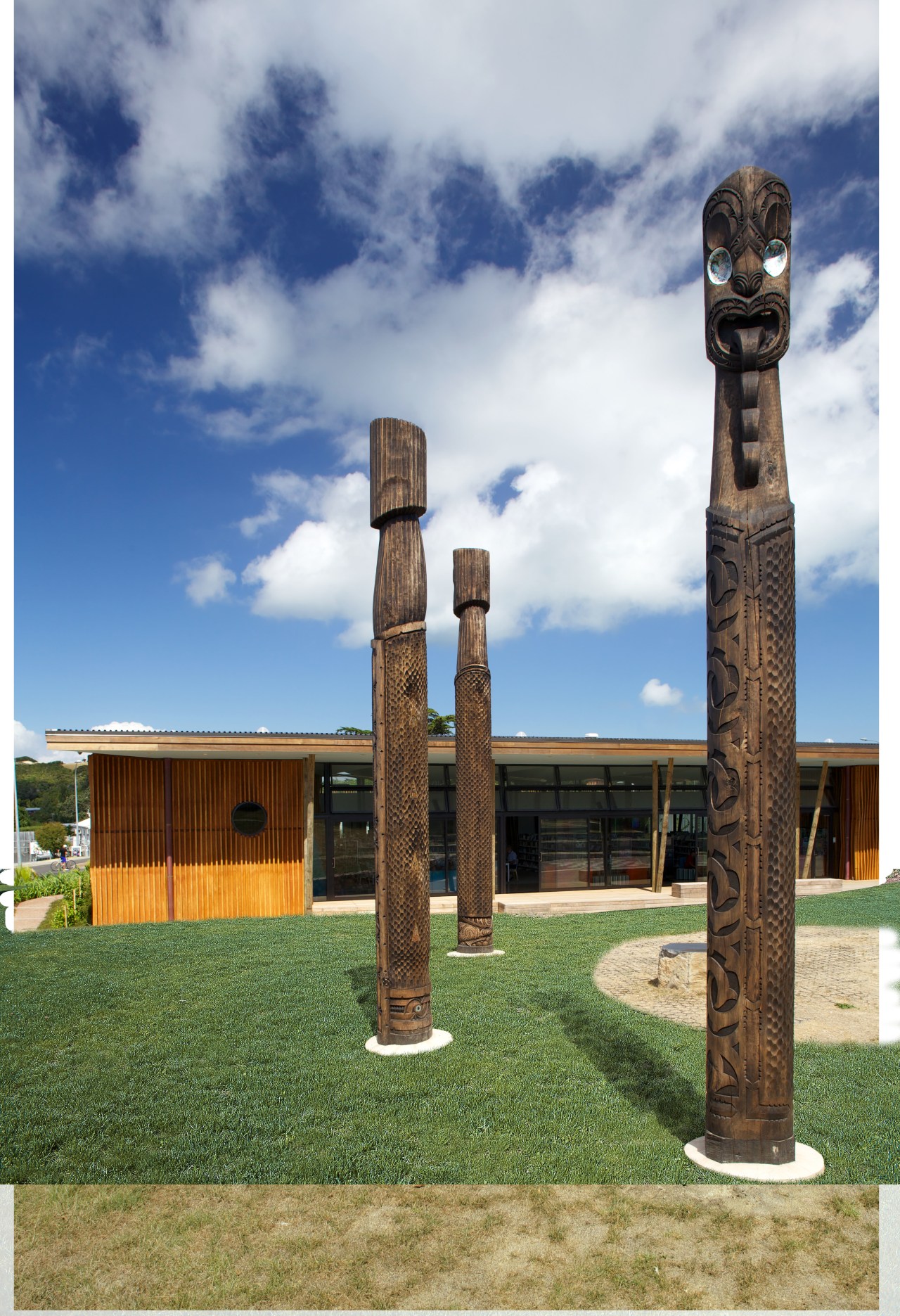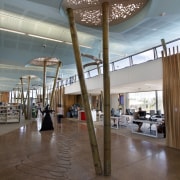Waiheke Island library gives the community a new home that references past, present, future
New library building on Waiheke Island features timber batten exterior with organic curved forms reminiscent of trees, plus local cultural references

For many people, lying beneath a spreading pohutukawa tree with a good book is one of the delights of a summer holiday at the beach.
Or, for those living on Waiheke Island in the Hauraki Gulf, it's something that can be enjoyed on any fine day. And it's this relaxed lifestyle that has been captured, quite literally, in the design of the new Waiheke library Waiheke Pataka Korero by architects Phillip Howard and Anthony Gibbs of Pacific Environments NZ.
"Both the exterior and interior convey the idea of a collection of books arranged beneath a canopy of pohutukawa trees," the architect says. "Angled columns reference the trunks, and perforated ceilings mimic the canopy. There are also screens of timber battens wrapping the building that resemble the spines of a row of books.
"The textured battens were designed by local artist Kazu Nakagawa, with mirrored pairs cut from a single piece of timber. They were arranged by the design team, to create beautiful curved forms inspired by nature."
Howard says the battens serve other purposes as well they are low maintenance and the textured surface helps to discourage graffiti. They also reinforce visually the extensive sustainable design initiatives incorporated into the building, which is owned and operated by Auckland Libraries, a division of Auckland Council.
Corrina Meikle, a service delivery manager at Auckland Libraries, says the new library was commissioned to replace a much smaller library within a former builders' yard.
"The local community made it clear they did not want iconic architecture that would make a strong statement," she says. "They wanted something appropriate to Waiheke. The library needed to relate to the island culture and community. It had to be functional, relevant, and every aspect needed to be in harmony."
Meikle says the library also needed to provide a meeting place.

"The Waiheke Local Board envisaged the library being an anchor in the community a place where people would feel comfortable to come in to read books, study or to simply sit around. We also wanted to be able to use it as a venue for hosting local events."
To this end, the design team provided a strong connection between inside and out, with three sides of the library opening up to the outdoors.
"To help blur the line between indoors and outdoors we pulled the idea of the timber trunks and battens to the inside of the library as well," says Howard. "Plywood leaf canopies beneath skylights at the top of each trunk were replicated from photos of pohutukawa tree canopies. The same pattern appears on the exterior canopies."
Timber battens screen a behind-the-scenes work area, while still providing a sense of transparency. They also form the balustrading on stairs leading to a pirate's crows nest, which is a balcony where children can read or enact stories.
Another feature of the children's area is a white painted leafy screen that semi conceals a bench seat where children can hide away.
"There is a limited amount of built-in furniture in the library," says Howard. "It made more sense to keep shelving systems and desks loose and flexible so they can be moved easily in the future."
The undulating ceiling, in a colour inspired by the underside of a pohutukawa leaf, reinforces the natural look of the timber. The folds also help with the acoustics, dampening echoes.
Polished concrete flooring defines key circulation areas, and reinforces another visual theme from artist Kazu Nakagawa. His artwork, titled forty-nine letters, pays tribute to Waiheke's climate. The phrase Lots of rain, lots of sun, lots of wind, lots of day, lots of night is literally embedded into the fabric of the building it is written across the building with overlapping calligraphic script that forms a lyrical pattern of repeating text.

Other significant visual references include three carved totara pou in the outdoor courtyard. These are oriented to three traditional sightlines of the Ngati Paoa people one towards Gannet Rock in the Hauraki Gulf, where waka landed on first arrival in Aotearoa. This references the past. Another pou is oriented towards the high school and the rising sun, symbolising youth and the future; and a third pou is oriented towards Piritahi Marae and its hill (maunga), which references the present.
An installation of photovoltaic panels, which is awaiting imminent approval, is set to generate enough electricity to meet all the energy requirements over the summer months. The library relies on natural ventilation and cooling, with heat pumps assisting cooling in the smaller enclosed rooms during peak occupancy.
Passive design features include ample natural light through high-level glazing and skylights. The thermal mass of the concrete floor supplements the solar energy during the winter, while conversely the low thermal mass of the timber decking on the north-facing elevation mitigates heat being radiated back into the building in summer. Similarly, large eaves shade the library in summer.
The building also features underground rainwater collection tanks, and there is a filter system for stormwater treatment and disposal.
Meikle says the completed building has far exceeded expectations.
"The community is enjoying the facilities, and there is a clear indication the local people are proud of it they regard this as their space', which is exactly what we hoped to achieve."
Credit list
Location
Architect
Civil engineer
Quantity surveyor
Cladding
Flooring
Lighting
Security system installation
Client
Construction company
Mechanical and electrical engineer
Landscaping
Paints
Story by: Colleen Hawkes
Photography by: Jamie Cobel
Home kitchen bathroom commercial design
Personality plus
Diving into nature
Classic looks, contemporary efficiency
Commercial Design Trends Vol. 31/7
Commercial Design Trends is aimed at our professional readers, and showcases commercial buildings. The book features reg...
Read More











